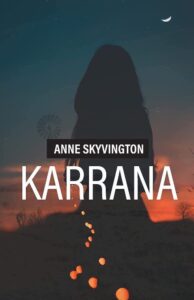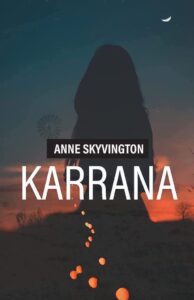
Writing Karrana was a journey of struggle that demanded new learning, passion and persistence. Even though the original idea was based largely on my parents’ love story and subsequent challenges faced as a family, the novel in its writing, forged its own thematic raison d’etre and called for a different and surprising structure and plot pyramid as it progressed. The novel had become by the end a work of fiction: A woman’s struggle to grow up and to find meaning in life set within a historical setting.
The Inspiration
Every story begins somewhere, and for me, the seed of Karrana was sown during my childhood and that of my close female ancestors. I wanted to capture the essence of bountiful nature and mystical places stored in my memory bank, with their dreamlike allure, as well as the irony of fate in all its manifestations, positive and negative. Karrana, with its raw yet beautiful natural appeal and realistic country characters, emerged from this desire to give voice to the past while keeping a connection to modernity and to the present as well.
Developing the Concept
Once the idea took root, I began shaping the concept. Karrana was to be more than a location—it was to embody themes of female desire and ambition and masculine willpower that still exist and inform society today and that, by the end of the novel, had pulled the characters into the modern world of the Sixties.
Creating the World of Karrana
The setting was paramount. I wanted the fictional town of Karrana to feel alive. Its streets, its people, its secrets—all had to breathe with authenticity. I delved into extensive research, exploring history, geography, and culture that could inform my creation. I layered these details carefully to ensure Karrana felt both universal and unique—a place that readers could imagine but also yearn to visit. Opposition between city and country life at the time was an important theme throughout. And celebrating the end of the Second World War in the Pacific was an appropriate starting point.
Characters: The Heart of the Tale
Characters are the lifeblood of any story, and crafting them was both exciting and challenging. I wanted each one to resonate, to feel flawed and relatable. Whether it was the restless protagonist seeking meaning or the enigmatic elder holding the town’s secrets, I imbued each with a history and motivations that shaped their actions. I spent hours creating their lives, hearing their voices, and understanding their fears and desires. It helped that many characters were based on actual personnages that I had known, or were composites or reflections of these.
The Writing Process
Writing Karrana was a daily ritual. I set aside dedicated hours, often in the early morning when the world was still, and my imaginative faculties were in play, to immerse myself in the story. Some days were fruitful, words flowing effortlessly; others were arduous, each sentence a struggle. Yet, persistence was key. I learned to embrace the ebbs and flows, trusting that every moment spent with the manuscript brought me closer to completion.
The Role of Feedback
Feedback was invaluable. I had joined and started several writing groups with peers during the time of the writing of Karrana. Bondi Writers Group, Waverley Writers and Randwick Writers were all invaluable for their inspiration and support. I shared details of my creative process in a book, created by members of RWG, ‘Sharing Writing Skills’, published in 2019 by Ginnindella. I shared drafts with trusted friends, mentors, and literary peers. Their insights helped me refine the narrative, sharpen dialogues, and deepen character arcs. I learnt how to accept constructive criticism, seeing my work as a product, which was essential for growth. The novel became richer and more nuanced through these collaborative efforts.
Challenges and Triumphs
The journey was not without its hurdles. There were moments of self-doubt, where I questioned whether the story was memoir or fiction or whether I was capable of doing it justice. Learning how to create and store documents on the computer was one of the hardest lessons for me, not to mention self publishing the final drafts on Kindle Direct Publishing. Yet, each challenge brought a lesson—about patience, persistence, and the art of storytelling. Finishing Karrana was a triumph in itself, a testament to passion and perseverance.
The Final Touches
Editing was where the story truly took shape. I wanted to create a tight and appealing structure. Before long, I found and worked with an editor, Laurel Cohn, who helped me discover overarching themes and set me on the right pathway towards fulfilment of my goals. I scrutinized every sentence, ensuring clarity, coherence, and rhythm. Excellent cover designs were offered by Evan Shapiro at Green Avenue Designs. https://www.greenavenue.com.au/ Formatting, and marketing followed, each step a new learning curve but one that brought immense satisfaction.
Reflection and Gratitude
Now, as I hold Karrana in my hands, I am filled with gratitude. Gratitude to all those mentioned above and to the ones I haven’t included here. The journey of writing this novel was as complex and rewarding as the story itself. It taught me about creativity, connection, and the power of persistence. Above all, it reminded me of the magic of storytelling—the ability to transport, transform, and inspire.
A special thanks to those who attended my book launch at Gleebooks in Glebe and especially to my husband who launched the book and to Geraldine Star who directed an excellent question-and-answer session and who put me at ease with her magical touch.
The Inspiration
Every story begins somewhere, and for me, the seed of Karrana was sown during my childhood and that of my close female ancestors. I wanted to capture the essence of bountiful nature and mystical places stored in my memory bank, with their dreamlike allure, as well as the irony of fate in all its manifestations, positive and negative. Karrana, with its raw yet beautiful natural appeal and realistic country characters, emerged from this desire to give voice to the past while keeping a connection to modernity and to the present as well.
Developing the Concept
Once the idea took root, I began shaping the concept. Karrana was to be more than a location—it was to embody themes of female desire and ambition and masculine willpower that still exist and inform society today and that, by the end of the novel, had pulled the characters into the modern world of the Sixties.
Creating the World of Karrana
The setting was paramount. I wanted the fictional town of Karrana to feel alive. Its streets, its people, its secrets—all had to breathe with authenticity. I delved into extensive research, exploring history, geography, and culture that could inform my creation. I layered these details carefully to ensure Karrana felt both universal and unique—a place that readers could imagine but also yearn to visit. Opposition between city and country life at the time was an important theme throughout. And celebrating the end of the Second World War in the Pacific was an appropriate starting point.
Characters: The Heart of the Tale
Characters are the lifeblood of any story, and crafting them was both exciting and challenging. I wanted each one to resonate, to feel flawed and relatable. Whether it was the restless protagonist seeking meaning or the enigmatic elder holding the town’s secrets, I imbued each with a history and motivations that shaped their actions. I spent hours creating their lives, hearing their voices, and understanding their fears and desires. It helped that many characters were based on actual personnages that I had known, or were composites or reflections of these.
The Writing Process
Writing Karrana was a daily ritual. I set aside dedicated hours, often in the early morning when the world was still, and my imaginative faculties were in play, to immerse myself in the story. Some days were fruitful, words flowing effortlessly; others were arduous, each sentence a struggle. Yet, persistence was key. I learned to embrace the ebbs and flows, trusting that every moment spent with the manuscript brought me closer to completion.
The Role of Feedback
Feedback was invaluable. I had joined and started several writing groups with peers during the time of the writing of Karrana. Bondi Writers Group, Waverley Writers and Randwick Writers were all invaluable for their inspiration and support. I shared details of my creative process in a book, created by members of RWG, ‘Sharing Writing Skills’, published in 2019 by Ginnindella. I shared drafts with trusted friends, mentors, and literary peers. Their insights helped me refine the narrative, sharpen dialogues, and deepen character arcs. I learnt how to accept constructive criticism, seeing my work as a product, which was essential for growth. The novel became richer and more nuanced through these collaborative efforts.
Challenges and Triumphs
The journey was not without its hurdles. There were moments of self-doubt, where I questioned whether the story was memoir or fiction or whether I was capable of doing it justice. Learning how to create and store documents on the computer was one of the hardest lessons for me, not to mention self publishing the final drafts on Kindle Direct Publishing. Yet, each challenge brought a lesson—about patience, persistence, and the art of storytelling. Finishing Karrana was a triumph in itself, a testament to passion and perseverance.
The Final Touches
Editing was where the story truly took shape. I wanted to create a tight and appealing structure. Before long, I found and worked with an editor, Laurel Cohn, who helped me discover overarching themes and set me on the right pathway towards fulfilment of my goals. I scrutinized every sentence, ensuring clarity, coherence, and rhythm. Excellent cover designs were offered by Evan Shapiro at Green Avenue Designs. https://www.greenavenue.com.au/ Formatting, and marketing followed, each step a new learning curve but one that brought immense satisfaction.
Reflection and Gratitude
Now, as I hold Karrana in my hands, I am filled with gratitude. Gratitude to all those mentioned above and to the ones I haven’t included here. The journey of writing this novel was as complex and rewarding as the story itself. It taught me about creativity, connection, and the power of persistence. Above all, it reminded me of the magic of storytelling—the ability to transport, transform, and inspire.
A special thanks to those who attended my book launch at Gleebooks in Glebe and especially to my husband who launched the book and to Geraldine Star who directed an excellent question-and-answer session and who put me at ease with her magical touch.







Leave A Comment